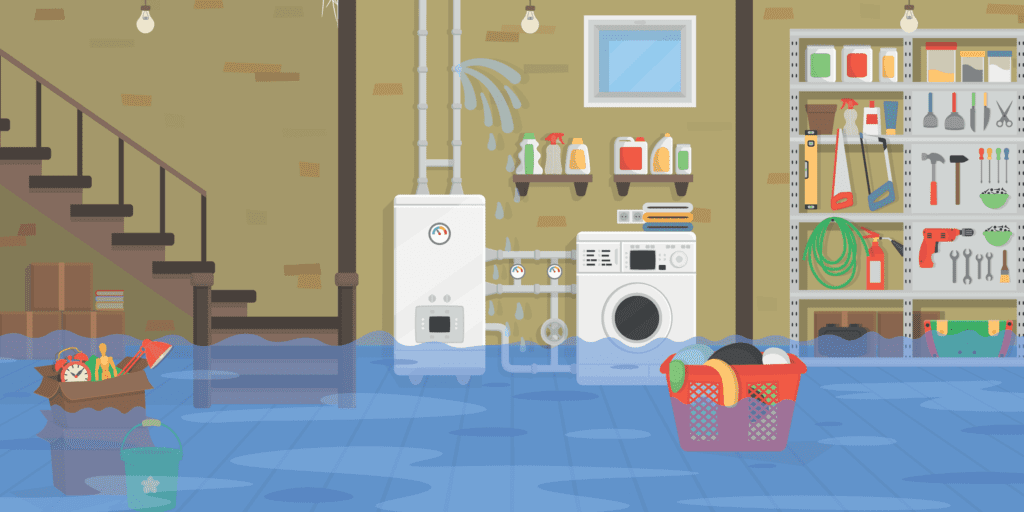Table of Contents
What To Do After a Rain When Your Basement Floods
The feeling of a strong downpour may be both soothing and relaxing, but when it results in a flooded basement, it can rapidly become a homeowner’s worst nightmare. Your home may sustain serious harm from a flooded basement, including the growth of mold, structural problems, and the loss of priceless things. To limit the harm and stop more issues, it is crucial to maintain composure and act quickly and contact basement repair companies. In this blog, we will explore the crucial actions to do if your basement leaks after a rainstorm.
Steps to Take When Your Basement Floods After Flood
Ensure Personal Safety
It’s critical to put your safety first before venturing into your flooded basement. Making sure to prevent any potential electrocution risks, turn off the power supply to the troubled region. It is preferable to wait for a specialist to evaluate the situation before entering if the water level is high.
Determine the Source
Knowing where the flooding is coming from can help you decide what to do next. A busted pipe, inadequate grading, defective gutters or downspouts, or a lot of rain are examples of common causes. Determine the cause, and if it was brought on by outside elements like rain, think about taking preventive action in the future by enhancing drainage or installing a sump pump.
Roof leaks might cause your basement flooding if your roof is broken or leaking. Contact an expert roofing company or locate specialists that can examine and repair your roof, use a search for “roofing expert near me” or “Indiana roofing contractors.”
Remove The Water
Eliminating the water is the first step in preventing basement flooding. You should engage a specialist in water restoration depending on how severe the flooding was. You can start by extracting the water with a wet vacuum, a submersible pump, a mop, and buckets if the water level is relatively low. Do not forget to properly dispose of the water far from the home’s foundation.
Prevention and Waterproofing
Consider putting waterproofing measures in place to stop future basement flooding. This can entail setting up a sump pump, caulking wall, and floor cracks, ensuring appropriate drainage around your home, and maintaining gutters and downspouts to keep water from collecting near the foundation.
Assurance Claim and Expert Assistance
To begin the claims procedure and report the water damage, get in touch with your insurance provider. Give them the evidence you have already obtained, including pictures and videos. They will walk you through the process and explain the details of your policy’s coverage. If the damage is severe or you feel overburdened, you might want to think about contacting a professional water damage repair business that specializes in basement flood cleanup and restoration.
Dry the Area
After the majority of the water has been pumped out, it is essential to completely dry the damaged area. Utilize fans or dehumidifiers to hasten drying while opening windows and doors to increase airflow. To stop mold from growing and causing more harm, remove any moist furniture, rugs, or other items.
Inspect For Damage
For any indications of structural harm or weak foundations, carefully investigate your basement. On the walls, flooring, or ceiling, look for any cracks, lumps, or discoloration. It’s best to get in touch with a qualified contractor or structural engineer if you discover any severe problems so they can make the required repairs and give your home a complete inspection.
Cleaning and Disinfecting
Sewage, germs, and other dangerous compounds are frequently carried by floodwaters, which are contaminated. To stop germs from spreading and mold from growing on the harmed surfaces, a complete disinfection is required. Clean all surfaces, including walls, floors, and any salvageable items, with a bleach solution or a specialist disinfectant designed for flood cleanup.
Prevent Mold Growth
Preventative precautions are essential since mold may grow within 24 to 48 hours of a flood. To treat the surfaces you’ve just cleansed, use an antibacterial or mold inhibitor. Maintaining ideal moisture levels in the basement requires sufficient ventilation, so think about adding a dehumidifier.
Take Preventive Measures
It’s crucial to take precautions after a basement flood to lessen the likelihood of such accidents happening again. Think about putting in a sump pump, keeping up with your gutters and downspouts, and sloping your property better to divert water away from the foundation. Keep an eye out for any indications of moisture accumulation or water leaks in your basement.
Tips to Prevent Basement Floods
Maintain Your Gutters and Downspouts:
Improper drainage is one of the main reasons basements flood. Make sure your gutters and downspouts are in good shape to avoid this. They should be cleaned frequently to get rid of dirt, leaves, and other material that might block the system. To keep water from your basement walls, make sure your downspouts reach at least five feet from the foundation.
Sealing Cracks and Gaps:
Check the walls and flooring of your basement for any cracks or openings that can enable water to leak through. Fill these gaps with epoxy or hydraulic cement to provide a waterproof seal. To provide an additional layer of defense against moisture, use waterproof paint or coatings.
Consider Landscaping:
When planning your landscaping, consider the possible influence on water flow around your property. Planting trees or huge plants too close to your foundation might damage the integrity of your basement walls and create water infiltration channels. Choose water-absorbing plants, such as native plants with deep root systems.
Maintain Backup and Sump Pump Systems:
A sump pump is a crucial piece of equipment for avoiding basement flooding. Check and maintain your sump pump frequently to make sure it is operating properly. Pouring water into the sump pit will allow you to check it out and see if the pump works properly to remove the water. To offer safety during power outages, think about adding a backup sump pump system that is powered by batteries.
Install French Drain:
French drains should be installed since they are efficient at diverting water away from your foundation. In these subterranean drainage systems, surplus water is collected and diverted through a perforated pipe that is encircled by gravel or rock. The danger of flooding in your basement can be decreased with proper French drain installation and routing.
Waterproof Your Basement Walls:
You might want to think about waterproofing your basement walls to add an added degree of security. To stop water from penetrating the outer walls, a waterproofing membrane or sealant must be applied. Water seepage can also be controlled with the use of internal waterproofing technologies, such as the installation of a drainage system along the inside perimeter.
Monitor and Control Moisture Levels:
The humidity levels in your basement must be kept under control if you want to stop mold development and other moisture-related problems. If you want to keep your space at the ideal 50% moisture level, think about utilizing a dehumidifier. Humidity may also be decreased with the aid of proper ventilation, such as opening windows or utilizing fans.
Conclusion
After a lot of rain, dealing with a flooded basement can be frightening, but with quick action and the right advice, you can reduce damage and successfully repair your house. Keep in mind to put safety first, minimize damage, thoroughly clean and disinfect, and take precautions to prevent more floods. Don’t be afraid to ask for help from professionals in serious situations. You can control basement flooding and guard your property against potential water damage by following the instructions in this detailed guide. In times of serious damage or ambiguity, don’t be afraid to seek professional assistance from an expert roofing company for services such as roof repair in Indiana or Michigan commercial roofing. Contact reliable specialists in your area for house foundation repair. Contact us for further information and advice on how to successfully tackle basement flooding. Our first concerns are the safety and repair of your house.
- Check the outside drainage systems of your home to make sure they are clean and working correctly. Downspouts should be directed away from the foundation. Investigate waterproofing techniques including sealants, waterproofing membranes, and exterior drainage systems, and think about adding a sump pump.
- To help the airflow in your wet basement dry out, open the windows. Dehumidifiers and fans can be used to lower the moisture content. To stop the formation of mold, remove moist carpets, furniture, and other items. Before starting the cleansing and repair, make sure the area is completely dry.
- The first action is to clear your basement of any standing water. Start at the lowest position and work your way to the exit by sucking up the water using a submersible pump or a wet/dry vacuum. This speeds up the drying process and minimizes further damage.

